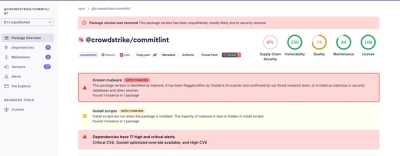
Research
Malicious fezbox npm Package Steals Browser Passwords from Cookies via Innovative QR Code Steganographic Technique
A malicious package uses a QR code as steganography in an innovative technique.
Picostyle is a 0.4 KB CSS-in-JS library for use with frameworks that expose an h function.
Update: Picostyle is now faster by removing JSON.stringify and supports a new css function that returns a class name for Components that support a class attribute property.
Currently tested with:
Install with npm or Yarn.
npm i picostyle
Then with a module bundler like Rollup or Webpack, use as you would anything else.
import picostyle from "picostyle"
Otherwise, download the latest release or load directly from unpkg or jsDelivr.
<script src="https://unpkg.com/picostyle"></script>
Then find it in window.picostyle.
Picostyle will work with any framework that exposes an h function. When you pass Picostyle an function h it returns a higher order function (HOF) that you can use exactly like the h you pass it.
Picostyle can now return an object with the style function and a new css fucntion when the new "return object" flag is true
import { h } from "some-framework"
import picostyle from "picostyle"
const style = picostyle(h)
Or
import { h } from "some-framework"
import picostyle from "picostyle"
const returnObject = true
const { style, css } = picostyle(h, returnObject)
The HOF accepts a tag name (or an unstyled component) and returns a function that accepts JSON styles.
// Styled component from tag name
const Wrapper = style("div")({
minHeight: "100vh",
background: "#000",
})
// Styling an un-styled component
const Component = (props, text) => h("h1", props, text)
const Text = style(Component)({
color: "#fff",
})
// Styling a component that supports a class name attribute
const Component = (state) => (
h("h1",
{
class: css( { color: "#fff" } )
}
)
If you want to change the style based on the props, you can do it by passing a function, instead of JSON styles.
// Here we set the color of the button, based on the color prop
const Button = style("button")(props => ({
color: props.color
}))
You can also use @keyframes animation importing keyframes function.
import picostyle, { keyframes } from 'picostyle'
const zoom = keyframes({
from: {
transform: 'scale(0.5)'
},
to: {
transform: 'scale(2)'
},
})
const Container = ps('div')({
animation: `${zoom} 300ms`,
})
You can now use the styled components to build your app.
const App = h("main", {}, [
Wrapper({}, Text("Scoping CSS is hard")),
Wrapper({}, Text("Not with styled components!")),
Wrapper({color: 'red'}, Button("I'm red!")),
])
Picostyle transforms any provided JSON styles into plain CSS styles and injects them into a style tag in the head of the document; all under unique style identifiers (USI). Each styled component is given a USI as a class name.
Because the output is a stylesheet and not inline styles. You can use all valid CSS in your JSON styles. For example:
@media (orientation: portrait))::before, :hover, :last-child).> h1, > *+*)import picostyle from "picostyle"
import { h, render } from 'preact';
const ps = picostyle(h)
const keyColor = "#f07";
const Text = ps("a")({
fontSize: "64px",
cursor: "pointer",
color: "#fff",
padding: "0.4em",
transition: "all .2s ease-in-out",
textDecoration: "none",
":hover": {
transform: "scale(1.3)",
},
"@media (max-width: 450px)": {
fontSize: "32px",
},
})
const Wrapper = ps("div")({
display: "flex",
justifyContent: "center",
alignItems: "center",
width: "100vw",
height: "100vh",
backgroundColor: keyColor,
})
render((
<Wrapper>
<Text href="https://github.com/morishitter/picostyle">Picostyle meets Preact</Text>
</Wrapper>
), document.body);
import { h, app } from "hyperapp"
import picostyle from "picostyle"
const style = picostyle(h)
const theme = "hotpink" // Try change the theme to white
const Wrapper = style("div")({
display: "flex",
width: "100%",
height: "100vh",
backgroundColor: theme,
"> h1": { cursor: "pointer" }
})
const Text = style("h1")({
fontSize: "calc(10px + 5vmin)",
color: theme === "white" ? "black" : "white",
margin: "auto",
transition: "transform .2s ease-out",
":hover": {
transform: "scale(1.2)",
},
"@media (orientation: landscape)": {
fontWeight: "bold",
},
})
app({
state: {
text: "Picostyle"
},
view: (state) =>
<Wrapper>
<Text>Hello { state.text }</Text>
</Wrapper>
})
/** @jsx */
import {h, patch} from "ultradom"
import picostyle from "picostyle"
const ps = picostyle(h)
function view(state) {
const keyColor = "#f07";
const Text = ps("h1")({
fontSize: "64px",
cursor: "pointer",
color: "#fff",
padding: "0.4em",
transition: "all .2s ease-in-out",
":hover": {
transform: "scale(1.3)",
},
"@media (max-width: 450px)": {
fontSize: "32px",
},
})
const Wrapper = ps("div")({
display: "flex",
justifyContent: "center",
alignItems: "center",
width: "100vw",
height: "100vh",
backgroundColor: keyColor,
})
return (
<Wrapper>
<Text>{state.trim() === "" ? ":)" : state}</Text>
</Wrapper>
)
}
document.body.appendChild(patch(view("Hello, Picostyle")))
FAQs
Most lightweight CSS in JS library ever.
The npm package picostyle receives a total of 3,776 weekly downloads. As such, picostyle popularity was classified as popular.
We found that picostyle demonstrated a not healthy version release cadence and project activity because the last version was released a year ago. It has 1 open source maintainer collaborating on the project.
Did you know?

Socket for GitHub automatically highlights issues in each pull request and monitors the health of all your open source dependencies. Discover the contents of your packages and block harmful activity before you install or update your dependencies.

Research
A malicious package uses a QR code as steganography in an innovative technique.

Research
/Security News
Socket identified 80 fake candidates targeting engineering roles, including suspected North Korean operators, exposing the new reality of hiring as a security function.

Application Security
/Research
/Security News
Socket detected multiple compromised CrowdStrike npm packages, continuing the "Shai-Hulud" supply chain attack that has now impacted nearly 500 packages.